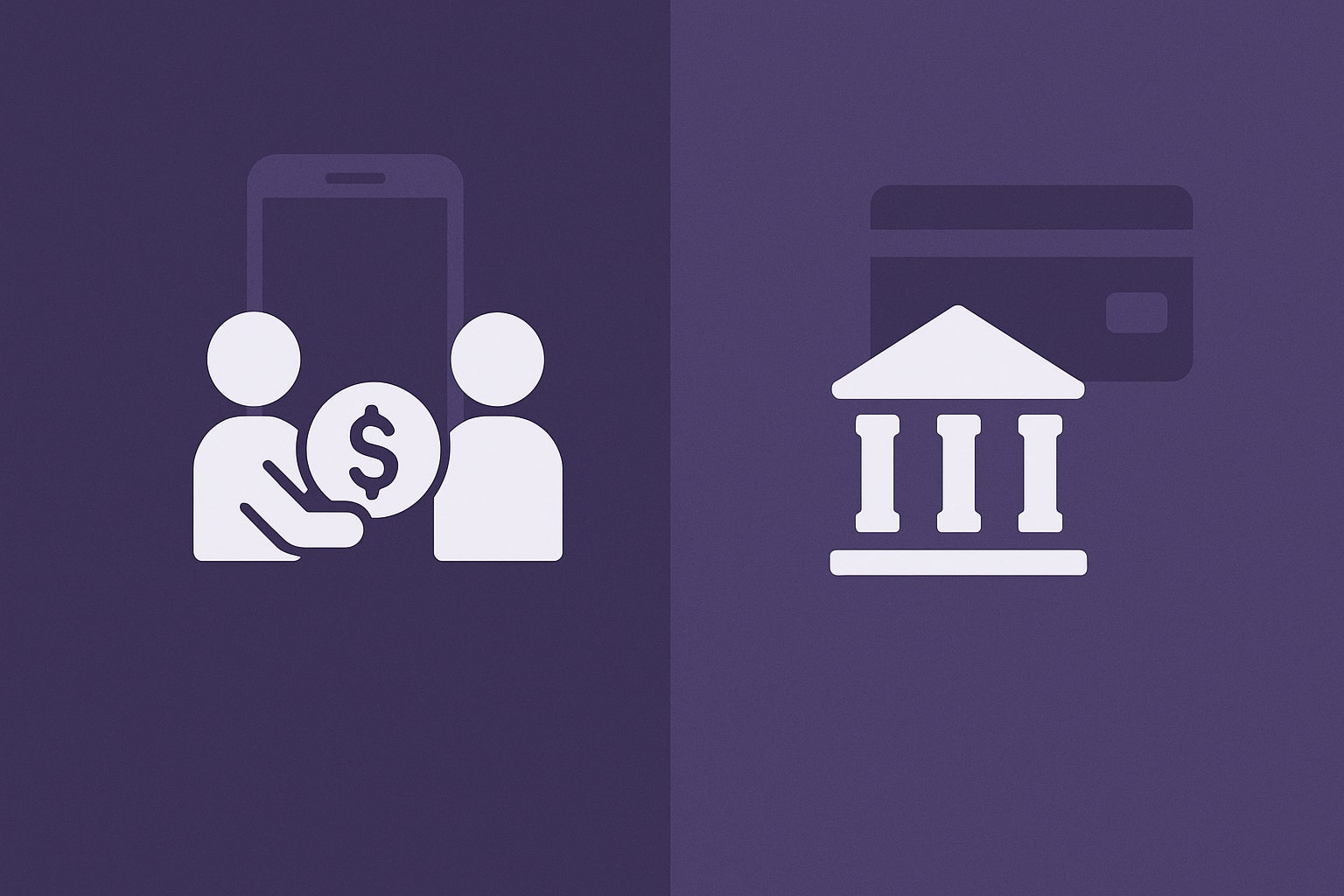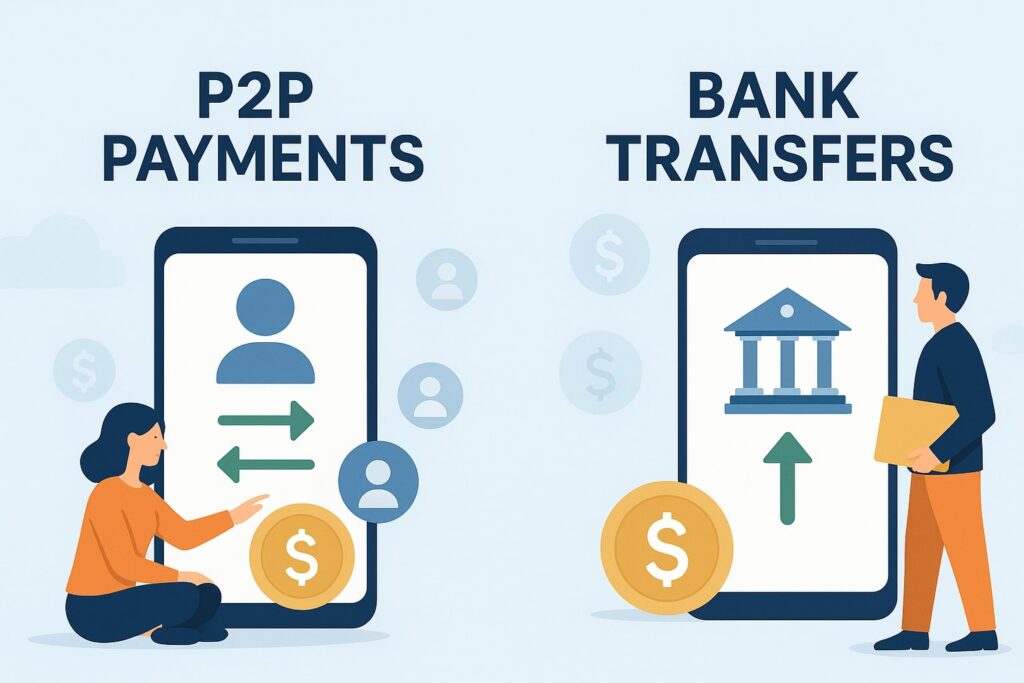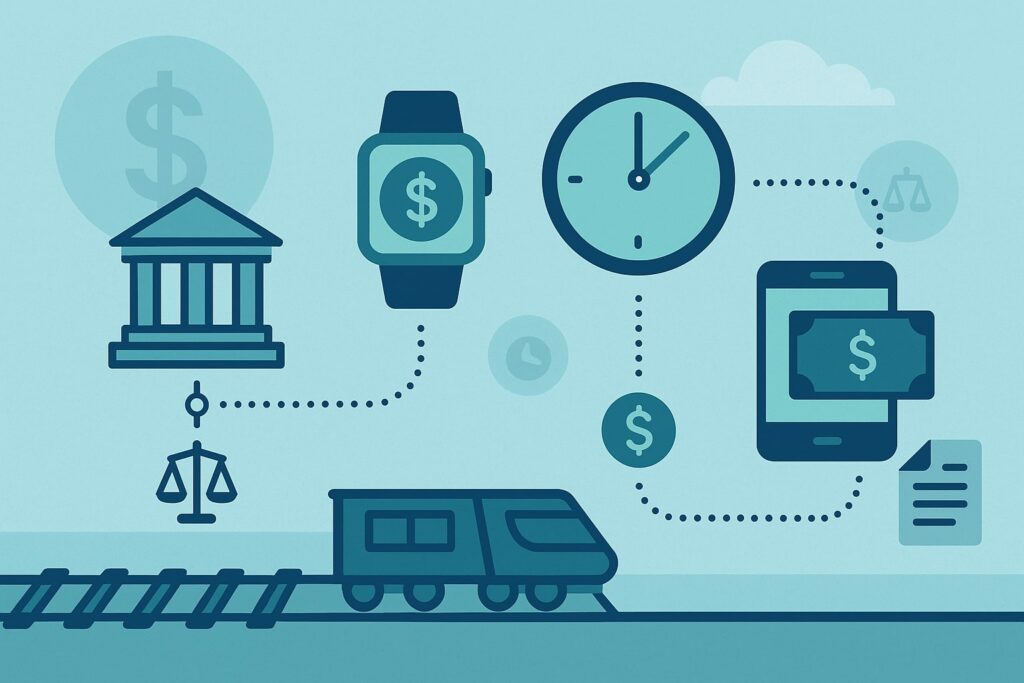
By p2pbusinesspayments October 26, 2025
P2P payments vs bank transfers is a comparison that every U.S. consumer and small business should understand. Both move money digitally, both can look instant in an app, and both promise convenience.
Yet the rails, rules, fees, speeds, protections, and risks are not the same. Choosing the right option for each situation can improve cash flow, reduce fees, and lower fraud exposure. This guide breaks down P2P payments vs bank transfers in plain English, using U.S. terminology and norms.
You’ll learn how each method works behind the scenes, what “instant” truly means, how disputes and reversals differ, what to expect on limits and holds, and where tax and compliance enter the picture.
By the end, you’ll know when P2P payments shine, when traditional bank transfers are superior, and how to avoid the most common pitfalls that cost time and money.
What Are P2P Payments and What Are Bank Transfers?

When people say P2P payments vs bank transfers, they’re comparing two broad categories. P2P payments (peer-to-peer) are app-based transfers between individuals or small businesses that feel social and instant.
Think of paying a roommate for utilities, splitting dinner, or collecting for a group gift. Popular apps let you send funds tied to an email, username, or phone number and they often show “instantly available” balances within the app’s wallet.
That balance may be spendable inside the ecosystem even if the underlying bank movement settles later. P2P payments emphasize convenience, emojis, and simple requests, and they often include built-in messaging or QR codes.
Many P2P apps also offer “business profiles” for micro-merchants and side hustles, but terms for commercial use differ from personal use.
Bank transfers are account-to-account movements on banking rails. The most common are ACH (Automated Clearing House), domestic wire transfers, and increasingly real-time payments (RTP on The Clearing House network and FedNow).
ACH is the U.S. workhorse for payroll and bills—low-cost but not instant. Wires are expensive but final and fast, suited to high-value or time-critical payments. Real-time options aim for instant credit to the recipient’s bank account 24/7/365 with irrevocable settlement.
Bank transfers are governed by specific banking rules and regulations, and they move money directly between deposit accounts. They tend to be more formal, with stronger controls for business payments, but they may require routing numbers, account numbers, or a bank directory alias.
The short version: P2P payments vs bank transfers boils down to app convenience and social features versus direct-to-bank settlement with mature controls. Each fits different moments. Understanding how they move funds and what the rules allow is the key to choosing wisely.
How the Money Actually Moves (Rails, Timing, and Settlement)

The most misunderstood part of P2P payments vs bank transfers is settlement. In many P2P apps, you see an instant in-app balance. That balance is often a stored value or ledger credit maintained by the app or its bank partner.
You can typically use it right away to pay another user inside the same app. However, moving those funds out to your bank may take longer or incur an “instant cash-out” fee.
If you pick a standard transfer to a bank, it typically rides ACH and completes in a day or two, not seconds. If you pay the instant cash-out fee, the app uses proprietary methods or card “push-to-card” rails (OCT/Push-to-Debit) to speed things up.
Bank transfers work differently. ACH batches transactions several times per day; same-day ACH exists, but windows and cut-offs still matter. Settlement is efficient and inexpensive, but not immediate to the second. Wires move funds quickly, with same-day finality when initiated before cut-offs, but fees are significant.
Real-time payments (RTP and FedNow) are built for immediate, final crediting 24/7/365, supporting request-for-payment and richer data, and funds land directly in the receiving bank account. Because they settle in real time, those funds are typically immediately usable in deposit accounts.
In practice, P2P payments make the experience feel instant, while bank transfers, especially via RTP/FedNow, make the settlement instant. That distinction matters for cash-flow-critical scenarios.
If you need money usable inside your bank account right now without extra fees, a real-time bank transfer is best. If you’re staying within one app’s ecosystem or paying friends, P2P’s instant ledger is usually plenty.
Speed and Availability: “Instant” Means Different Things
Comparing speed in P2P payments vs bank transfers requires nuance. P2P apps are “always on,” but moving money into and out of the app can introduce delays. Standard bank withdrawals from the app often rely on ACH, with funds available the next business day or two.
Many P2P networks now offer instant cash-out options that are very fast but often come with a small percentage fee or per-transaction charge. If you frequently need immediate cash at the bank level, those fees can add up.
Bank transfers have distinct profiles. ACH has predictable timing, with traditional next-day or two-day settlement and risk windows. Same Day ACH can speed availability, but it is still batch-based, with dollar limits and cut-offs set by the network and your bank.
Wires are typically same-day when initiated early enough, and they settle with finality; however, both sending and receiving banks may charge fees, and wires are business-day dependent. RTP/FedNow stand apart by offering true 24/7/365 instant settlement directly into bank accounts, often within seconds, with no batch windows or business-day limits.
If your decision hinges on “I need my funds in my bank right now,” bank real-time rails are the gold standard. If you prioritize in-app speed and social convenience, P2P payments win. For most day-to-day person-to-person uses, P2P is fast enough.
For business-critical disbursements, payroll emergencies, and after-hours vendor payments, real-time bank rails usually provide the most reliable immediacy.
Cost and Fees: What You Actually Pay
When evaluating P2P payments vs bank transfers, consider explicit fees and hidden costs. P2P apps often market free person-to-person transfers. That’s true inside the app for standard moves. But instant cash-out to your bank can carry a percentage fee.
Business profiles inside P2P apps may also incur merchant-style processing fees on incoming payments, and commercial use usually has stricter terms. In addition, some P2P platforms monetize through optional features like branded debit cards, cashback, crypto conversions, or early direct deposit features.
Bank transfers vary. ACH is generally low-cost; many banks bundle ACH payments in business account packages with modest per-item charges, and some fintech platforms pass through minimal fees.
Wires carry the highest fees for both senders and sometimes receivers, justified by speed, finality, and manual controls. Real-time bank payments (RTP/FedNow) are typically priced between ACH and wires; banks and fintechs are still refining their fee schedules for these rails.
For recurring business payments—payroll, vendor payables, subscriptions—low-cost ACH often wins. For high-value, time-sensitive settlements, a wire or real-time rail is worth the premium.
The total cost also includes risk management overhead. If a P2P payment goes to the wrong handle or a scammer, recovery can be difficult. If an ACH debit is returned, you may spend time collecting again.
If you wire to the wrong account, reversal may be impossible. Smart routing that picks the right rail for the job reduces both fees and follow-up costs.
Security and Protections: Rules, Regs, and Reality

Another core difference in P2P payments vs bank transfers is the security model and consumer protections. P2P platforms use encryption, device checks, risk scoring, and behavioral analytics to flag suspicious activity.
Many also provide optional PINs or biometric locks and warnings for potential scams. However, once you authorize a P2P payment to the wrong person or a scammer, recovery is difficult.
The protections you have may vary by the platform’s user agreement and whether the transfer is considered unauthorized (someone hacked you) or authorized (you sent it but were deceived).
Bank transfers sit within the U.S. banking framework. ACH consumer debits are covered by Regulation E for unauthorized electronic fund transfers, giving consumers defined error-resolution rights and time windows.
ACH credits and business-to-business transfers often follow different rules with shorter dispute windows and responsibilities negotiated in agreements. Wires are usually final, with clear responsibility for verification and limited recall mechanisms.
Real-time bank payments are designed to be irrevocable, so fraud controls and confirmation steps are critical before sending. In short, the type of error matters more than the channel. Unauthorized access often has stronger protections. Authorized payments to a fraudster are tough everywhere.
That means education, verification, and simple habits—like confirming handles and using “request to pay” links you initiate—are as important as the technology itself in both P2P payments and bank transfers.
Typical Use Cases: When Each Method Shines
Use cases are where the P2P payments vs bank transfers decision becomes practical. P2P payments excel at daily life: splitting rent, rideshares, gifts, and small reimbursements. Their social feed-style UI lowers friction and makes collecting from multiple people simple.
Many platforms now support small-business profiles, letting sole proprietors or side hustles accept quick payments without formal invoicing.
Bank transfers are best for structured financial flows. ACH rules for payroll files, vendor payables, subscriptions, and tuition are tested and affordable. Wires work for high-value closings, escrow, and settlements where finality is critical.
RTP/FedNow fill the “instant and final” gap for urgent disbursements, after-hours payouts, and just-in-time supplier payments that can’t wait for Monday morning. For cross-bank person-to-person transfers where you want funds in the recipient’s checking account right now, real-time bank rails are increasingly compelling.
A healthy financial toolkit uses both. Keep P2P for quick social transfers and light commercial activity within platform rules. Use ACH for recurring bills and payroll.
Reserve wires and RTP/FedNow for time-critical, high-value, or irrevocable needs. That approach usually minimizes fees and risk while maximizing speed when it matters most.
Limits, Holds, and Account Reviews
In P2P payments vs bank transfers, limits can surprise users. P2P platforms enforce per-transaction, daily, and monthly caps, with higher limits available after identity verification or account history.
Large or unusual activity may trigger temporary holds or manual review to combat fraud and ensure compliance, especially for new accounts or sudden spikes. “Instant cash-out” amounts may have separate thresholds from standard ACH withdrawals.
Banks impose their own ACH, wire, and real-time payments limits based on account type, tenure, and risk settings. Corporate accounts often can request higher limits with controls like dual approval, allow-lists, or positive pay.
Real-time payments rails also have network-level caps that can evolve, plus institution-specific settings. Expect your first large transfer on a new platform or account to encounter verification checks. Planning ahead—submitting documents, enabling approvals, and warming up activity—reduces disruption.
Remember: holds are not punishment; they’re how platforms and banks deter fraud and comply with regulations. If timing is crucial, verify your limits days in advance and keep a fallback channel ready.
Disputes, Reversals, and Chargebacks
Disputes work differently across P2P payments vs bank transfers. In P2P apps, there usually isn’t a formal “chargeback” like with card payments. If you sent money to the wrong person or were scammed, the app may try to contact the recipient, but recovery is not guaranteed, especially for authorized transfers.
Unauthorized access cases (e.g., account takeover) receive stronger support if reported promptly. For business profiles within P2P apps, dispute handling follows the platform’s commercial terms, which can include more scrutiny and documentation requirements.
In bank transfers, ACH has defined return codes. An ACH debit can be returned for reasons like insufficient funds or unauthorized transactions, with time windows. ACH credit pushes generally cannot be yanked back unilaterally once accepted, though exceptions and bank-to-bank cooperation exist.
Wires are largely final—recalls are rare and rely on recipient cooperation. RTP/FedNow are built as irrevocable; pre-send checks and confirmation are paramount. The guiding principle is: the faster and more final the rail, the more the burden shifts to preventing mistakes before sending.
To protect yourself, enable two-factor authentication, confirm recipient details with out-of-band verification, and use business-grade controls like dual approval for larger transfers. Treat every first-time recipient like a high-risk payment until verified.
Business Use, Tax, and Recordkeeping
When comparing P2P payments vs bank transfers for business, think beyond speed. Business use of P2P apps is governed by separate terms. You typically must create a business profile to accept payments for goods and services, and fees may apply.
Some marketplaces and P2P platforms issue annual information reports to payees and the IRS when thresholds are met. The reporting thresholds for third-party settlement organizations have been evolving; always check current IRS guidance because the dollar amounts and timelines can change. Keep clean records of every sale and transfer regardless of channel.
For formal bookkeeping, bank transfers (ACH, wires, RTP/FedNow) integrate well with accounting and treasury workflows. Many banks and fintechs provide remittance data, reconciliation files, and approval logs.
ACH supports standardized addenda records to match invoices. Real-time bank rails are adding richer messaging to make reconciliation easier. If you’re operating a small business, it’s smart to route sales over card or bank acceptance designed for commerce, and use bank transfers for payroll and payables.
P2P is fine for reimbursements or tips where the platform permits, but mixing personal P2P flows with business income can complicate taxes.
Cross-Border Considerations
P2P payments vs bank transfers gets more complex across borders. Many U.S. P2P apps primarily support domestic transfers. Even if an app has international versions, cross-region transfers can be limited, and exchange rates or fees may be opaque.
If your recipient is abroad, you may need a remittance service, a cross-border wallet, or a multi-currency account to avoid delays and high costs. Traditional international wires remain the standard for large cross-border transfers, though fees and intermediary bank charges can be significant.
Fintech alternatives now provide low-cost cross-border ACH-like transfers to select countries with competitive FX. Compliance checks (sanctions screening, KYC) occur behind the scenes, which can add time.
For cross-border payroll or vendor payments, choose providers with transparent FX, clear timelines, and robust tracking. Always verify recipient names and IBAN/SWIFT details carefully—errors are costly to fix.
For small, casual payments to friends abroad, consider whether both parties share the same global wallet ecosystem. If not, a dedicated remittance platform with strong consumer protections and clear fees is safer than forcing a domestic-only P2P tool to do something it wasn’t meant to handle.
Integrations, APIs, and Automation
From an operations standpoint, P2P payments vs bank transfers diverge in integrations. P2P apps provide slick mobile experiences but limited API-level automation for businesses outside their official commerce features.
They’re excellent for ad-hoc payments and collections but less suited for automated back-office workflows like invoice matching, approval chains, and bulk payouts at scale.
Bank rails shine here. ACH is the backbone of automated disbursements and collections, with NACHA-compliant files and modern APIs from banks and fintech processors. RTP/FedNow enable real-time payment requests, ISO-style data fields, and automated reconciliation.
Many treasury platforms support multi-rail decisioning rules—route low-value recurring items over ACH, urgent or off-hours items over real-time, and very high-value settlements by wire. With the right provider, you can build rules-based payment orchestration to minimize fees and maximize speed, automatically.
If you’re a growing business, think of bank rails as the automation substrate. P2P payments remain an excellent front-end convenience for customer refunds, tips, or micro-transactions—when terms allow—but bank transfers and real-time rails are the backbone for scalable, auditable operations.
Risk, Fraud, and Best-Practice Hygiene
Fraudsters exploit speed and trust. In P2P payments vs bank transfers, the pressure to act right now is the hallmark of a scam. Common tactics include impostor messages (“your child needs funds”), fake marketplace overpayments, and spoofed payment requests.
Because authorized payments are hard to pull back on every rail, prevention is your best defense.
Adopt these habits:
- Verify first-time recipients using a known phone call or fresh email chain you start.
- Use in-app usernames you recognize; send a small test payment if unsure.
- Enable 2FA, app locks, and alerts for every send.
- Set approval workflows for business transfers, with dual control on large amounts.
- Beware of QR codes and links sent by strangers; initiate from your app.
- Slow down if the sender insists on urgency or secrecy.
P2P payments vs bank transfers doesn’t change the psychology of scams. It changes the consequences. Real-time finality raises the stakes. Take advantage of confirmation screens, name-check features where offered, and request-for-payment flows that reduce data entry errors.
Real-Time Payments (RTP & FedNow) vs P2P “Instant”
A hot topic within P2P payments vs bank transfers is real-time bank payments versus P2P instant balance. On P2P, an “instant” transfer usually means the recipient can spend inside that app immediately.
But to move the funds to their bank without fees may still take a day or two. On RTP/FedNow, the money lands in the bank account instantly, generally with final settlement and 24/7/365 availability. That difference is crucial for payroll emergencies, contractor payouts over the weekend, or supplier releases after hours.
RTP/FedNow also carry richer payment data that flows with the transfer, improving reconciliation. As more banks adopt these rails, expect billers to offer pay-by-bank experiences with immediate confirmation of receipt.
For consumers, that means fewer late fees due to weekend cut-offs. For businesses, it means tighter working capital and fewer exceptions. P2P will continue to lead for social convenience, but real-time bank rails are the future for serious money movement.
Choosing the Right Method: A Practical Decision Framework
Here’s a simple way to decide in the P2P payments vs bank transfers debate:
- Who are you paying?
Friends or family → P2P.
Vendors, employees, landlords → Bank rails. - How fast must it settle into a bank account?
Seconds, 24/7 → RTP/FedNow.
Same day and final → Wire.
One to two days, low cost → ACH.
In-app only is fine → P2P. - How much are you sending?
Small and casual → P2P.
Medium recurring → ACH.
Very large or high-stakes → Wire or RTP. - What records and protections do you need?
Formal invoices and audit trail → Bank transfers.
Casual reimbursements → P2P. - What are the fees?
Prefer low cost → ACH or standard P2P (no instant cash-out).
Will pay for speed → RTP or instant cash-out; wires for high-value.
With these steps, you’ll match each payment to the channel that fits your risk, speed, and cost profile.
Compliance and Evolving Rules: What to Watch
Because payments regulations and network rules evolve, treat P2P payments vs bank transfers as a living topic. Areas to monitor:
- Consumer protections and scam reimbursements policies at major platforms and banks.
- IRS reporting thresholds for third-party settlement organizations and marketplace payments.
- Network limits and features for Same Day ACH, RTP, and FedNow.
- Bank verification tools (account name checks, micro-deposits, open-banking APIs).
- Security enhancements like confirmation of payee, enhanced risk scoring, and stronger device binding.
Check official sources and your provider’s most recent terms before relying on a specific protection, limit, or timeline. The best practice is to design your process—verification, approvals, and reconciliations—so you’re safe even if a policy changes.
Future Trends Shaping P2P and Bank Transfers
Several trends will shape the next chapter of P2P payments vs bank transfers. First, pay-by-bank at checkout will expand as real-time rails spread and user experience improves, reducing card interchange on some transactions.
Second, request-for-payment will make bill pay less error-prone: a biller sends a request with exact details; you approve, and funds move instantly with matching data. Third, open-banking data sharing will improve account verification, reducing misdirected payments and fraud.
P2P apps will continue to innovate with richer commerce features, tipping, and creator monetization, while tightening controls against scams. Banks and fintechs will offer orchestration that selects the best rail per transaction based on amount, urgency, and risk.
Over time, the line between P2P and bank transfers will blur for consumers. What won’t change is the need to know what rail you’re truly on and the implications for speed, cost, and reversibility.
FAQs
Q.1: Is a P2P payment the same as a bank transfer?
Answer: No. P2P is usually an in-app ledger transfer with later movement to your bank via ACH or instant cash-out. A bank transfer moves money directly between bank accounts on ACH, wire, or real-time rails.
Q.2: Are P2P payments “instant”?
Answer: They feel instant in the app. Standard withdrawals to your bank often take one to two business days via ACH. Instant cash-out to the bank is fast but may have a fee.
Q.3: Which is cheaper: P2P or bank transfer?
Answer: For casual person-to-person transfers, P2P is often free. For business payments, ACH is typically the lowest-cost rail. Wires are expensive; RTP/FedNow pricing varies by provider but is usually less than wires.
Q.4: Which is safer?
Answer: Both are secure, but authorized payments to the wrong person are hard to recover on any rail. Bank rails offer mature controls and audit trails. Your habits—verification, 2FA, approvals—matter most.
Q.5: Can I use P2P for my business?
Answer: Only if the platform allows business use and you create a business profile. Fees and rules differ from personal use. For regular payroll and vendor payments, bank rails are a better long-term fit.
Q.6: What if I sent money to the wrong person on a P2P app?
Answer: Contact support immediately. They may request the recipient return funds, but recovery isn’t guaranteed. Always verify handles or send a small test first.
Q.7: Are real-time bank payments refundable?
Answer: They’re designed to be final. Confirm recipient details carefully and use approvals. If you suspect fraud, contact your bank immediately.
Q.8: How do taxes work for P2P income?
Answer: Keep records of all business income regardless of channel. Reporting thresholds for third-party settlement organizations can change; check current IRS guidance or consult a tax professional.
Q.9: Which method is best for paying rent?
Answer: If your landlord accepts ACH or pay-by-bank, that’s reliable and low-cost with better records. Some landlords accept P2P business accounts. Avoid sending to personal P2P handles unless lease terms allow it and you can document receipts.
Q.10: What’s the fastest way to get money into my bank on a weekend?
Answer: A real-time bank transfer (RTP/FedNow) moves funds directly into your account within seconds, 24/7/365. An instant P2P cash-out can also be fast but may charge a fee and use different rails.
Conclusion
The smartest way to approach P2P payments vs bank transfers is to match the rail to the task. Use P2P for what it does best—frictionless, social, everyday sharing—while recognizing that “instant” often means instant in-app.
Use ACH for predictable, low-cost recurring payments. Use wires for high-value settlements where finality is paramount. And use real-time bank rails when you need money in the bank this minute, day or night, with rich data for reconciliation.
No single rail wins every time. The winner is the workflow that balances speed, cost, control, and protection. Build habits that prevent mistakes, enable two-factor authentication, verify recipients, and keep clean records.
As U.S. payment options evolve, that foundation will keep your money moving safely and efficiently—no matter which channel you tap.